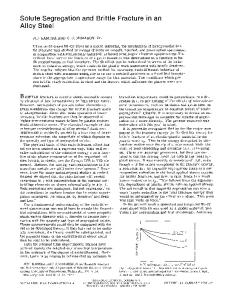Concentration-Independent Solute Segregation in Laser Annealing of Semiconductor Crystals
- PDF / 438,568 Bytes
- 6 Pages / 420.48 x 639 pts Page_size
- 72 Downloads / 332 Views
CONCENTRATION-INDEPENDENT SEMICONDUCTOR CRYSTALS
SOLUTE
SEGREGATION IN LASER ANNEALING OF
Jun-ichi Chikawa, Fumio Sato and Tadasu Sunada NHK Broadcasting Science Research Laboratories, 1-10-11, Kinuta, Setagaya-ku, Tokyo, 157, Japan
ABSTRACT Atomic processes at the interface in regrowth following laser induced melting were investigated by observing behavior of impurity segregation. The interfacial segregation coefficient k* was obtained from depth profiles of solute atoms redistributed by laser irradiation of uniformly doped Si, Ge, and GayAll-vAs crystals. It was found that k*=k0 for B in Si, Ga in Ge ih the growth rate range of 1 m/s. It is concluded that rapid growth freezes a state of liquid monolayer adjacent to the interface which has the character of ideal solution from dilute to eutectic composition for dopant-silicon systems and in the entire range of composition for the mixed crystal.
1. INTRODUCTION Pulsed lasers with a duration of several tens of nanoseconds can melt thin surface layers of semiconductor crystals. The molten layer crystallized at a speed of several meters per second epitaxially on the underlying crystal. Impurity segregation at the interface in such rapid crystal growth has been investigated extensively, and segregation phenomena due to non-equilibrium solidification have been observed [1]. The growth rates V exceeded diffusive speed of impurity atoms in the melt, i.e., V> D/a, where D is the diffusivity of impurity in the melt and a is the interatomic distance. The present authors, however, have been interested in a little slower growth (V
Data Loading...






